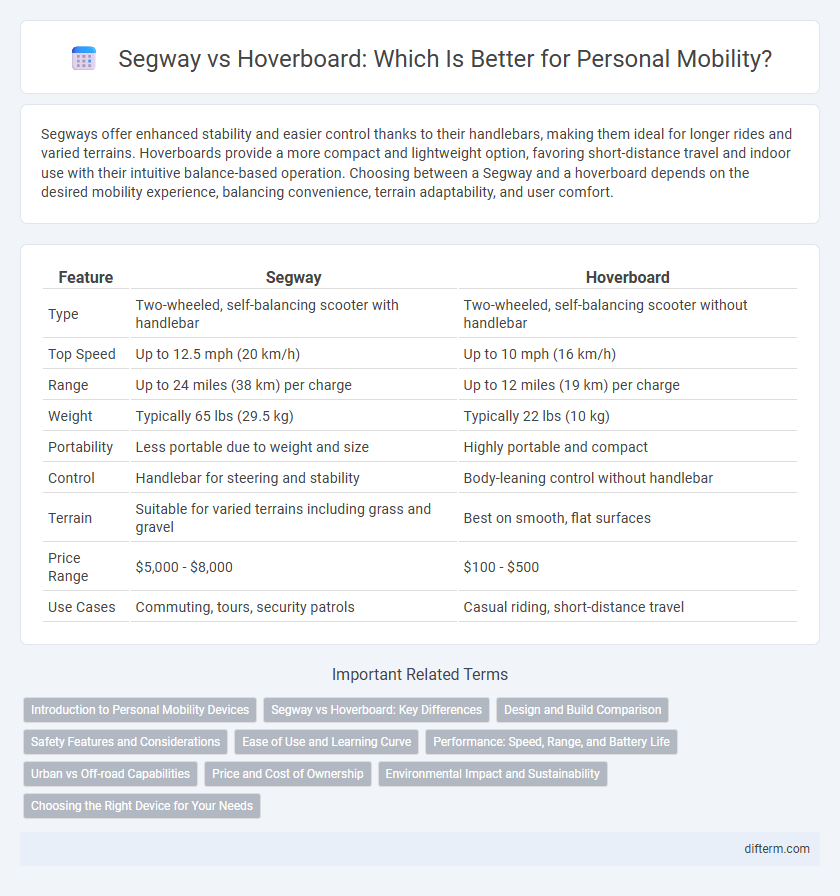Segways offer enhanced stability and easier control thanks to their handlebars, making them ideal for longer rides and varied terrains. Hoverboards provide a more compact and lightweight option, favoring short-distance travel and indoor use with their intuitive balance-based operation. Choosing between a Segway and a hoverboard depends on the desired mobility experience, balancing convenience, terrain adaptability, and user comfort.
Table of Comparison
| Feature | Segway | Hoverboard |
|---|---|---|
| Type | Two-wheeled, self-balancing scooter with handlebar | Two-wheeled, self-balancing scooter without handlebar |
| Top Speed | Up to 12.5 mph (20 km/h) | Up to 10 mph (16 km/h) |
| Range | Up to 24 miles (38 km) per charge | Up to 12 miles (19 km) per charge |
| Weight | Typically 65 lbs (29.5 kg) | Typically 22 lbs (10 kg) |
| Portability | Less portable due to weight and size | Highly portable and compact |
| Control | Handlebar for steering and stability | Body-leaning control without handlebar |
| Terrain | Suitable for varied terrains including grass and gravel | Best on smooth, flat surfaces |
| Price Range | $5,000 - $8,000 | $100 - $500 |
| Use Cases | Commuting, tours, security patrols | Casual riding, short-distance travel |
Introduction to Personal Mobility Devices
Personal mobility devices such as Segways and hoverboards revolutionize urban transportation by providing compact, electric-powered options for short-distance travel. Segways feature self-balancing technology with handlebars for enhanced stability and control, making them suitable for varied terrains and longer rides. Hoverboards offer a more compact, handle-free design that emphasizes portability and ease of use, ideal for smooth surfaces and casual commuting.
Segway vs Hoverboard: Key Differences
Segways feature handlebars and advanced gyroscopic sensors that provide enhanced stability and control compared to hoverboards, which rely on rider balance without handlebars. Segways offer greater speed range, typically up to 12.5 mph, and extended battery life allowing longer travel distances, while hoverboards usually max out around 6-8 mph with shorter battery endurance. The safety profile of Segways is generally higher due to their design and robust build, making them suitable for urban commuting and professional use, whereas hoverboards are often preferred for casual, recreational riding.
Design and Build Comparison
Segways feature a robust, upright design with handlebars for enhanced stability, built with durable materials suited for varied terrains. Hoverboards offer a compact, low-profile build with footpads and self-balancing technology, emphasizing portability and ease of use on smooth surfaces. The Segway's frame supports extended rides and control, while hoverboards prioritize lightweight construction for quick maneuverability and casual mobility.
Safety Features and Considerations
Segways incorporate advanced safety features such as gyroscopic stabilization, intuitive handlebar control, and built-in speed limits to reduce the risk of accidents, making them suitable for diverse terrains and users. Hoverboards rely heavily on balance sensors and auto-calibration but have been associated with overheating battery incidents, prompting manufacturers to improve fire-resistant materials and certification standards. Users should prioritize certified models with strong safety ratings and wear protective gear irrespective of device choice to mitigate injury risks.
Ease of Use and Learning Curve
Segways feature a self-balancing system with a handlebar, offering intuitive control and stability that reduces the learning curve for users new to personal mobility devices. Hoverboards require mastering balance on two independent platforms without handlebars, making their ease of use more challenging for beginners. Users looking for quick adaptability often prefer Segways due to their straightforward operation and enhanced safety features.
Performance: Speed, Range, and Battery Life
Segways typically offer higher speeds up to 12.5 mph and longer ranges of around 24 miles, supported by larger batteries that provide extended ride times. Hoverboards generally peak at speeds of 6 to 10 mph with a range of 7 to 12 miles, relying on smaller batteries suited for shorter commutes. Battery efficiency on both devices depends on terrain and rider weight, but Segways maintain superior performance for longer, faster travel.
Urban vs Off-road Capabilities
Segways excel in urban environments with their stable design, larger wheels, and advanced balance technology, making them ideal for smooth pavements and city commuting. Hoverboards, featuring smaller wheels and a more compact frame, perform best on flat, even surfaces and struggle on rough, uneven terrain, limiting their off-road capabilities. Off-road hoverboards with rugged tires exist but generally do not match the Segway's superior suspension and stability for challenging outdoor conditions.
Price and Cost of Ownership
Segways typically have higher upfront prices ranging from $600 to $8,000, reflecting their advanced technology and durability compared to hoverboards, which generally cost between $150 and $600. The cost of ownership for Segways includes maintenance, battery replacement, and potential repairs, which can be more expensive due to their complex mechanisms and parts. Hoverboards, while cheaper initially, may incur frequent battery and motor replacements, leading to higher long-term expenses despite the lower purchase price.
Environmental Impact and Sustainability
Segways and hoverboards differ significantly in environmental impact, with hoverboards generally consuming less energy due to their smaller motors and lighter weight, resulting in lower carbon emissions per mile traveled. While Segways offer longer battery life and greater range, their heavier build and more complex components lead to increased resource use and electronic waste. Sustainable mobility choices favor hoverboards when prioritizing energy efficiency and reduced material consumption, though both devices contribute to eco-friendly urban transportation by reducing reliance on fossil-fuel vehicles.
Choosing the Right Device for Your Needs
Segways offer greater stability and longer battery life, making them ideal for urban commuting and extended use, while hoverboards provide enhanced portability and maneuverability suited for shorter distances and recreational use. Consider your daily travel distance, terrain, and convenience preferences when selecting between a Segway or hoverboard. Evaluating factors such as speed, weight capacity, and ease of storage ensures the optimal choice for personal mobility requirements.
segway vs hoverboard Infographic

 difterm.com
difterm.com